
CURATOR’s EYE
Learn about PRIYANKA SINGH in 3 minutes
Follow TRiCERA on Instagram and check out our creative artists
5%OFF & free shipping 1st purchase
FIRSTART5
10%OFF 2nd purchase after 1st purchase!
Welcome to TRiCERA
Hi there! We are pleased to have you here 🎉
Could you please describe yourself?
Guest
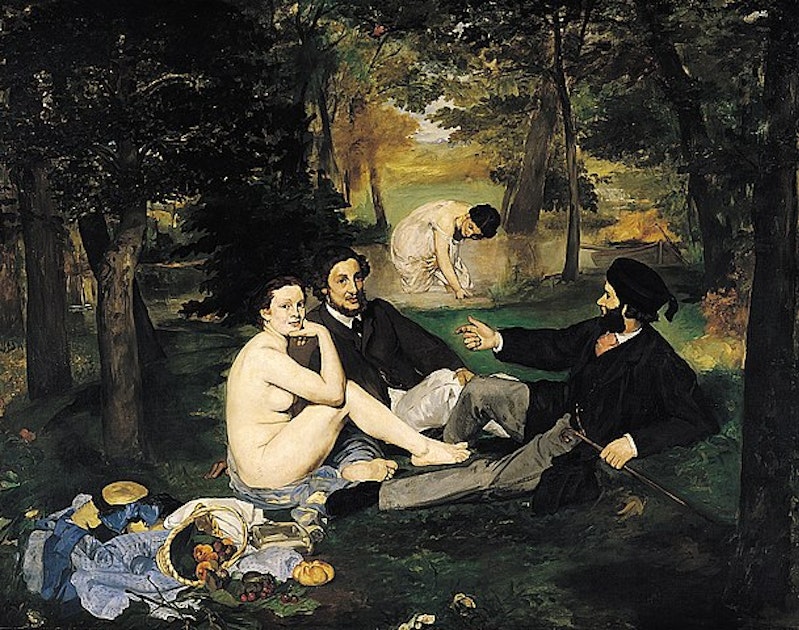
Lunch on the Grass, 1862-1863, Musée d'Orsay
Lunch on the Grass" was a controversial and shocking work in the Paris art world in the 19th century.
In this issue, we will provide an explanation of the work and of the artist, Manet.
Artist: Edouard Manet
Year: 1862-1863
Material: oil on canvas
Dimensions: 208 cm × 265.5 cm
Collection: Musée d'Orsay, Paris
In the 19th century, the Salon, the official exhibition organized by the Royal Academy, was the center of the art world in Paris. It was the most prestigious honor for an artist to be selected to exhibit his work at the Salon.
Manet also exhibited "Lunch on the Grass" at the Salon, but it was not selected because it depicted "a real nude woman," which was considered immoral.
There was also an exhibition called "Exhibition of the Unsuccessful," in which works that were not selected for the Salon were collected and exhibited. When Manet submitted his work to this exhibition, he received a great deal of criticism from critics for the same reason, creating a major scandal.
A view of the exhibition of unsuccessful applicants
Let's take a quick look at who the artist, Edouard Manet, was.
Manet was born in Paris in 1832 and died there in 1883.
Widely known as the "father of Impressionism," Manet was an innovator in painting, breaking free of traditional painting conventions by vividly depicting contemporary urban scenes and using clear outlines and flat colors.
Among other Impressionist painters, he maintained a particularly close relationship with Monet, frequently visiting Monet's Argenteuil home and creating works that incorporated Impressionist techniques such as outdoor production.
He is also famous for the "Lunch on the Grass" scandal discussed in this article, as well as for his "Olympia," which caused another major scandal.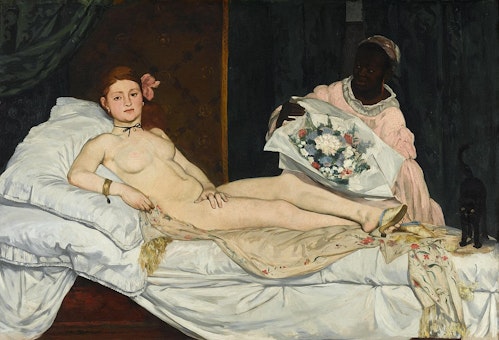
Olympia, 1863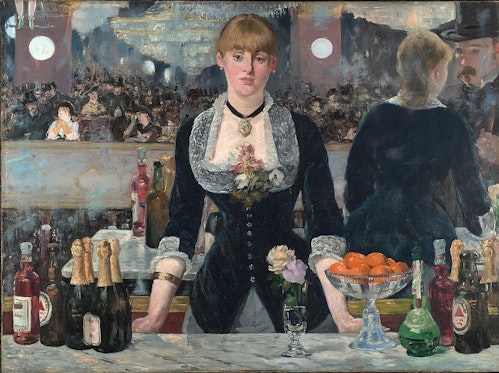
His last major work, The Bar at the Folies Bergère, 1882.
Why were Manet's works criticized to the point of scandal?
In academic painting, which was the mainstream at the time, and in the history of Western painting before that, nude women appeared in works depicting mythological or historical events.
Therefore, it can be said that Manet's depiction of "real nude women" in this work was groundbreaking, but at the same time, it was subject to criticism.
In fact, "Lunch on the Grass" is actually a composition that combines images from two previous masters' works with Manet's own modifications.
The background of Titian's "Rural Ensemble" is modeled on the three male and female figures in an early 16th-century etching by Marcantonio Raimondi based on Raphael's "The Judgment of Paris.
In Raimondi's work, the three figures are nude, but Manet painted the two men with clothes on and left only the women nude.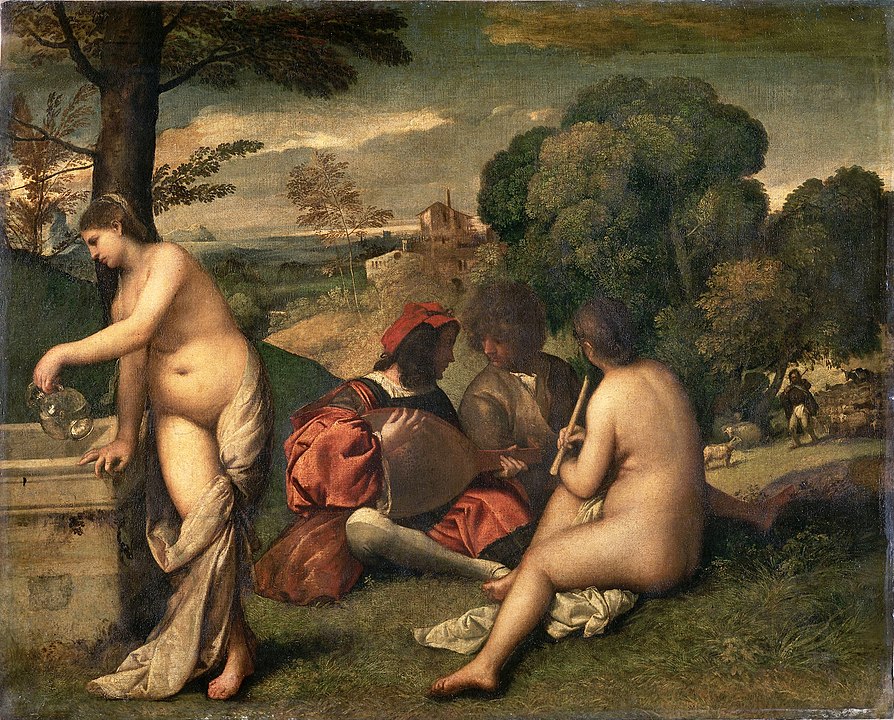
Titian, "Concerto in the Countryside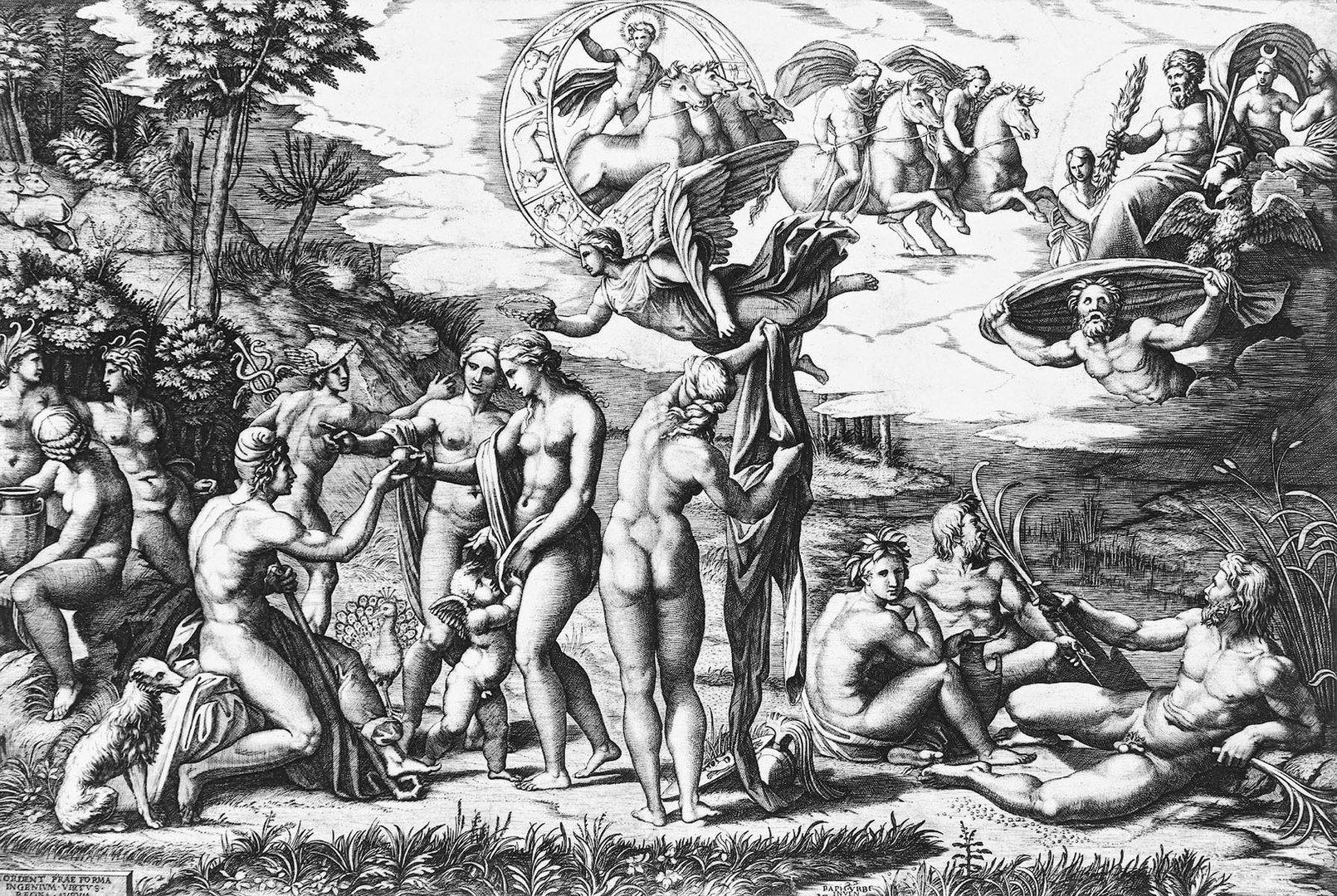
The Judgment of Paris, by Marcantonio Raimondi, see three figures at lower right.
The title of this work is now "Lunch on the Grass," but at the time of its publication, it was titled "Bathing.
In fact, one of Manet's other revolutionary contemporaries, Claude Monet, also saw this work and painted a tribute to it.
Monet, Lunch on the Grass, 1866, Musée d'Orsay
The year after Monet's painting was exhibited, Manet changed the title of his own work from "Bathing" to "Lunch on the Grass" in recognition of Monet.
It is interesting to note that the title suggests the active exchange between the young painters of the time.
As mentioned above, Manet's "Lunch on the Grass" is nothing more than a combination of the images of Titian and Raimondi, two painters from the past, and a modernized version.
However, the "modernization" was done by "depicting the nudes of women who had been portrayed as goddesses as the nudes of women, prostitutes, that people see in real life.
This was a bitterly ironic response to the current situation in the Salon, where historical paintings were the mainstream, and nudes were the object of male sexual desire under the name of "historical and mythological paintings.
Although the depicted nudes themselves are not so different, the way in which they are received changes completely depending on whether they are gods or men. The arbitrariness of such value judgments in art is highlighted by the fact that this work has drawn significant criticism.
Furthermore, this work practices Manet's characteristic way of painting flat motifs with light that seems to hit from the front.
In classical paintings, shadows created by light shining from oblique angles were usually depicted in gradations in order to express the volume of the human body.
In this painting, however, the flat application of paint and clear outlines are evident, especially in the way the nude woman is painted, as if she were emerging from the darker colors behind her in a flat plane.
This flat volumetric expression is also common in other works by Manet.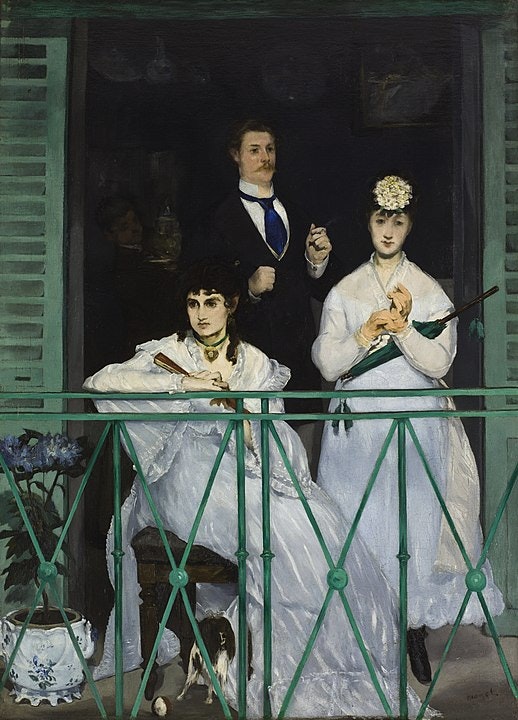
The Balcony, 1868-69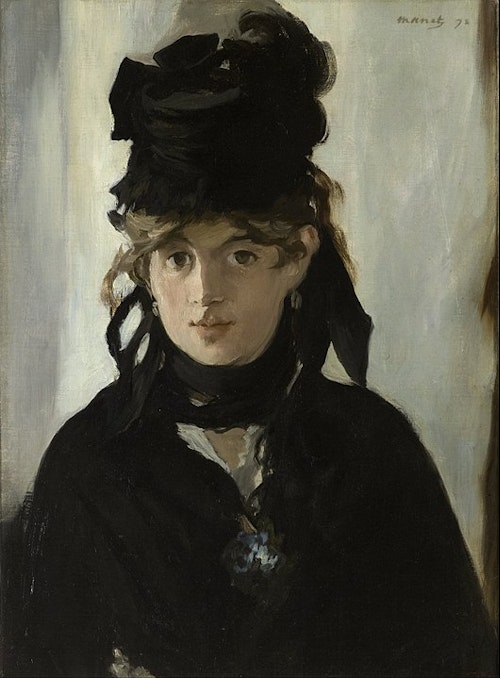
Berthe Morisot with a Bouquet of Violets, 1872
This much-talked-about work inspired artists as diverse as Monet, Cézanne, and Picasso, who painted homages to it.
For unknown reasons, Monet's "Lunch on the Grass" was cut into two parts before it was published by Monet himself, and has been preserved as the "center" and "left" sections.
.jpg)
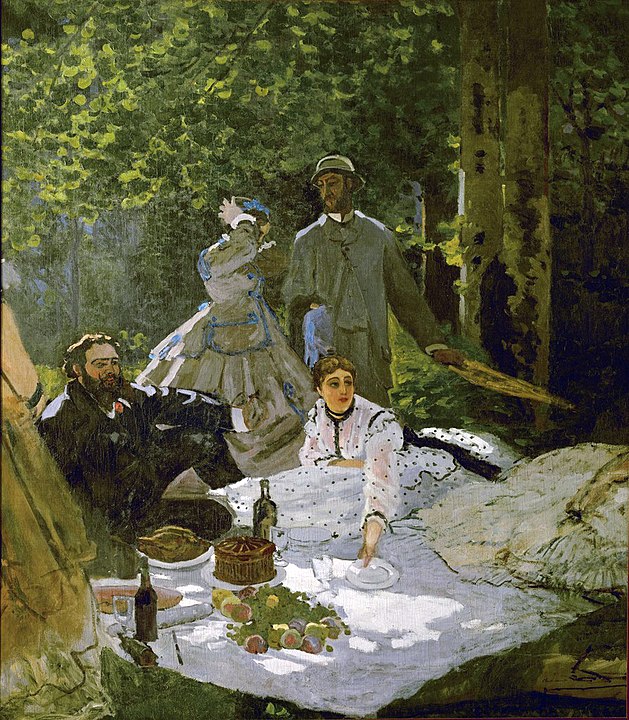
Lunch on the Grass, 1865-1866.jpg?w=500&h=381)
Lunch on the Grass, Cézanne, 1876 -1877
Cézanne probably saw Manet's "Lunch," but it is possible that he was merely expressing a pleasant memory of the countryside around Aix-en-Provence.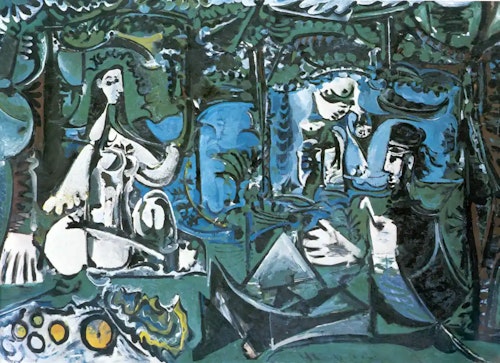
Lunch on the Grass, Picasso, 1960.
Although this work is a direct influence, it has also been suggested that Picasso's masterpiece, "Les Femmes d'Avignon," may have been inspired by Manet's painting.
James Tissot, La Partie Carrée, 1870
Herman Braun-Vega, Les invités sur l'herbe d'après Vélasquez, Manet et Picasso, 1970
This work greedily incorporates images not only from Manet's work, but also from Velázquez's "Las Meninas" and Picasso's works.

April in Paris by Serguei Zlenko
W 65.00cm x H 54.00cm / ¥554,300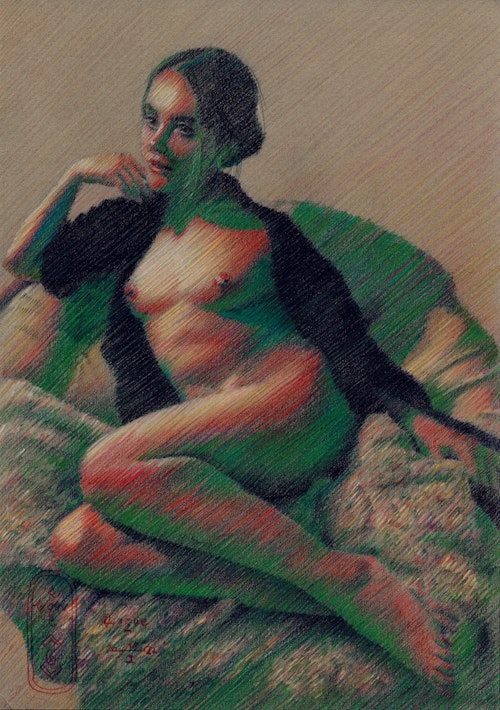
Risque - 18-01-22 by Corné Akkers
W 21.00cm x H 30.00cm / ¥429,100
Adele by Sean Christopher Ward
W 61.00cm x H 61.00cm / ¥148,500
Blue Miracle by Nobuko Shimizu
W 65.00cm x H 53.00cm / ¥300,000
Flower of the Beginning by Nori Yamamoto
W 91.00cm x H 73.00cm / 300,000Yen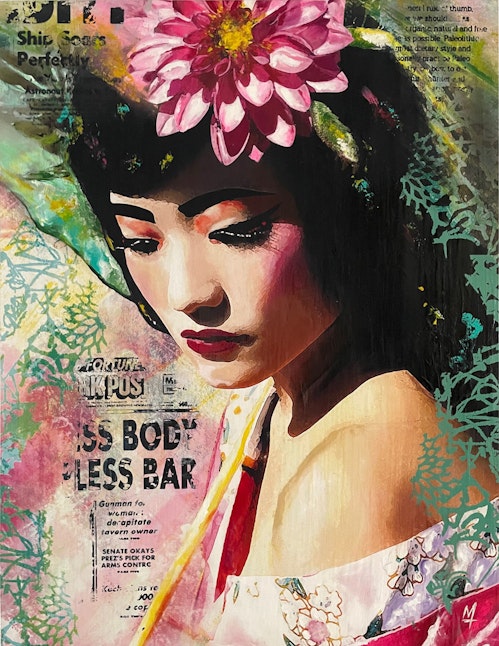
Geisha Hatsumomo by Milena B
W 70.00cm x H 90.00cm / ¥135,900
- Discounts such as members-only secret sales and coupons
- Create your own collection by registering your favorite artists
- Receive updates on popular artists, exhibitions, and events
- Receive a weekly newsletter with selected art
- Personal Assessment to find out what kind of art you like.
Please register as a member for free and receive the latest information.

Writer
TRiCERA ART

Lunch on the Grass, 1862-1863, Musée d'Orsay
Lunch on the Grass" was a controversial and shocking work in the Paris art world in the 19th century.
In this issue, we will provide an explanation of the work and of the artist, Manet.
Artist: Edouard Manet
Year: 1862-1863
Material: oil on canvas
Dimensions: 208 cm × 265.5 cm
Collection: Musée d'Orsay, Paris
In the 19th century, the Salon, the official exhibition organized by the Royal Academy, was the center of the art world in Paris. It was the most prestigious honor for an artist to be selected to exhibit his work at the Salon.
Manet also exhibited "Lunch on the Grass" at the Salon, but it was not selected because it depicted "a real nude woman," which was considered immoral.
There was also an exhibition called "Exhibition of the Unsuccessful," in which works that were not selected for the Salon were collected and exhibited. When Manet submitted his work to this exhibition, he received a great deal of criticism from critics for the same reason, creating a major scandal.
A view of the exhibition of unsuccessful applicants
Let's take a quick look at who the artist, Edouard Manet, was.
Manet was born in Paris in 1832 and died there in 1883.
Widely known as the "father of Impressionism," Manet was an innovator in painting, breaking free of traditional painting conventions by vividly depicting contemporary urban scenes and using clear outlines and flat colors.
Among other Impressionist painters, he maintained a particularly close relationship with Monet, frequently visiting Monet's Argenteuil home and creating works that incorporated Impressionist techniques such as outdoor production.
He is also famous for the "Lunch on the Grass" scandal discussed in this article, as well as for his "Olympia," which caused another major scandal.
Olympia, 1863
His last major work, The Bar at the Folies Bergère, 1882.
Why were Manet's works criticized to the point of scandal?
In academic painting, which was the mainstream at the time, and in the history of Western painting before that, nude women appeared in works depicting mythological or historical events.
Therefore, it can be said that Manet's depiction of "real nude women" in this work was groundbreaking, but at the same time, it was subject to criticism.
In fact, "Lunch on the Grass" is actually a composition that combines images from two previous masters' works with Manet's own modifications.
The background of Titian's "Rural Ensemble" is modeled on the three male and female figures in an early 16th-century etching by Marcantonio Raimondi based on Raphael's "The Judgment of Paris.
In Raimondi's work, the three figures are nude, but Manet painted the two men with clothes on and left only the women nude.
Titian, "Concerto in the Countryside
The Judgment of Paris, by Marcantonio Raimondi, see three figures at lower right.
The title of this work is now "Lunch on the Grass," but at the time of its publication, it was titled "Bathing.
In fact, one of Manet's other revolutionary contemporaries, Claude Monet, also saw this work and painted a tribute to it.
Monet, Lunch on the Grass, 1866, Musée d'Orsay
The year after Monet's painting was exhibited, Manet changed the title of his own work from "Bathing" to "Lunch on the Grass" in recognition of Monet.
It is interesting to note that the title suggests the active exchange between the young painters of the time.
As mentioned above, Manet's "Lunch on the Grass" is nothing more than a combination of the images of Titian and Raimondi, two painters from the past, and a modernized version.
However, the "modernization" was done by "depicting the nudes of women who had been portrayed as goddesses as the nudes of women, prostitutes, that people see in real life.
This was a bitterly ironic response to the current situation in the Salon, where historical paintings were the mainstream, and nudes were the object of male sexual desire under the name of "historical and mythological paintings.
Although the depicted nudes themselves are not so different, the way in which they are received changes completely depending on whether they are gods or men. The arbitrariness of such value judgments in art is highlighted by the fact that this work has drawn significant criticism.
Furthermore, this work practices Manet's characteristic way of painting flat motifs with light that seems to hit from the front.
In classical paintings, shadows created by light shining from oblique angles were usually depicted in gradations in order to express the volume of the human body.
In this painting, however, the flat application of paint and clear outlines are evident, especially in the way the nude woman is painted, as if she were emerging from the darker colors behind her in a flat plane.
This flat volumetric expression is also common in other works by Manet.
The Balcony, 1868-69
Berthe Morisot with a Bouquet of Violets, 1872
This much-talked-about work inspired artists as diverse as Monet, Cézanne, and Picasso, who painted homages to it.
For unknown reasons, Monet's "Lunch on the Grass" was cut into two parts before it was published by Monet himself, and has been preserved as the "center" and "left" sections.
.jpg)

Lunch on the Grass, 1865-1866.jpg?w=500&h=381)
Lunch on the Grass, Cézanne, 1876 -1877
Cézanne probably saw Manet's "Lunch," but it is possible that he was merely expressing a pleasant memory of the countryside around Aix-en-Provence.
Lunch on the Grass, Picasso, 1960.
Although this work is a direct influence, it has also been suggested that Picasso's masterpiece, "Les Femmes d'Avignon," may have been inspired by Manet's painting.
James Tissot, La Partie Carrée, 1870
Herman Braun-Vega, Les invités sur l'herbe d'après Vélasquez, Manet et Picasso, 1970
This work greedily incorporates images not only from Manet's work, but also from Velázquez's "Las Meninas" and Picasso's works.

April in Paris by Serguei Zlenko
W 65.00cm x H 54.00cm / ¥554,300
Risque - 18-01-22 by Corné Akkers
W 21.00cm x H 30.00cm / ¥429,100
Adele by Sean Christopher Ward
W 61.00cm x H 61.00cm / ¥148,500
Blue Miracle by Nobuko Shimizu
W 65.00cm x H 53.00cm / ¥300,000
Flower of the Beginning by Nori Yamamoto
W 91.00cm x H 73.00cm / 300,000Yen
Geisha Hatsumomo by Milena B
W 70.00cm x H 90.00cm / ¥135,900
- Discounts such as members-only secret sales and coupons
- Create your own collection by registering your favorite artists
- Receive updates on popular artists, exhibitions, and events
- Receive a weekly newsletter with selected art
- Personal Assessment to find out what kind of art you like.
Please register as a member for free and receive the latest information.

Writer
TRiCERA ART